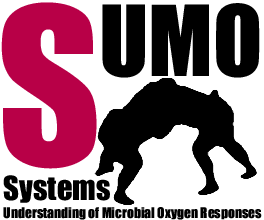| Version 18 (modified by rolfe, 16 years ago) (diff) |
|---|
SysMO - SUMO - Systems Understanding of Microbial Oxygen Responses
About this wiki
The SUMO wiki is the central communication platform for the exchange of information about experimental data, models, ideas and general issues. This subpage is the starting point for publicly available information about the project.
About SUMO
General Information
The bacterium Escherichia coli is a common inhabitant of the human gut but is also of special interest as a laboratory experimental tool; many decades of study have produced an impressive description of processes essential for life.
However we must now consider how the individual components that make up a biological system work together to produce coherent patterns of behaviour. We have chosen to investigate the responses of E. coli to oxygen availability, because:
- The system is composed of relatively simple modules that participate in complex interactions;
- There is a detailed parts list of the main regulatory systems (genome sequence, participating proteins, molecular mechanisms);
- There are existing published data sets and data from precursor projects that permit the integration of specific and sound mathematical modelling approaches from the very beginning of the project; and
- Powerful techniques for highly controlled and reproducible experiments are available (transcriptomics, facile genetics, chemostat culture);
- The system is biologically, medically and industrially significant.
This systems approach reveals new insight into the adaptations that occur in response to changes in oxygen availability and offer opportunities for efficient re-engineering for industrial purposes and target-identification for medical applications. We collectively obtain and analyse, using commonly agreed protocols, highly reproducible transcriptomic, proteomic, metabolomic and biochemical data sets that describe the dynamics of the response to oxygen. Data sets are integrated to elaborate predictive mathematical and computer science models in an iterative process of model-based hypothesis generation and experimental design.
Specifically, we investigate how this bacterium senses oxygen, or the associated changes in oxidation/reduction balance, via the Fnr and ArcA proteins, how these systems interact with other regulatory systems, and how the redox response of an E. coli population is generated from the responses of single cells. There are five sub-projects to determine system properties and behaviour and three sub-projects to employ different and complementary modelling approaches using published data sets and data emerging from our own work. We construct increasingly elaborate models of the system at different levels of detail, which are used to generate new hypotheses and influence further experimental design.
Workpackages
| WP1.1 Molecular Interations & Regulatory Modules (Poole & Green) | WP1.2 Carbon & Electron Fluxes (Teixeira de Mattos) | WP13 WP1.3 Isogenic Mutants (Bettenbrock) | WP14 WP1.4 Single Cells (Bettenbrock & Gilles) |
| WP2.1.1 Agent-based Modelling (Holcombe & Maleki-Dizaji) | WP2.1.2 From ''Escherichia coli'' Workflow using Taverna and Web Services (Holcombe & Maleki-Dizaji & Rolfe) | WP2.2 Reduced-order modelling (Gilles) | WP2.3 Detailed Kinetic Modelling (Sauter & Sawodny) |
Personal Pages
| Sheffield MBB | Robert Poole | Jeff Green | Alison Graham | Matthew Rolfe | |
| Sheffield DCS | Mike Holcombe | Afsaneh Maleki-Dizaji | |||
| Amsterdam SILS | Joost Teixeira de Mattos | Alex Ter Beek | |||
| Stuttgart ISYS | Oliver Sawodny | Sebastian Henkel | Thomas Sauter (now Université du Luxembourg) | ||
| Magdeburg MPI | Ernst Dieter Gilles | Katja Bettenbrock | Michael Ederer | Sonja Steinsiek | Stefan Stagge |
Publications
(related to SUMO, which acknowledge the support by SysMO)
- Bekker M., de Vries, S., Ter Beek, A., Hellingwerf, K. and Teixeira de Mattos, M. (2009). Non-electrogenic respiration by Escherichia coli: the quinol oxidase cytochrome bd-II does not contribute to oxidative phosphorylation, submitted.
- Green, J., Crack, J.C., Thomson, A.J. and Le Brun, N.E. (2009) Bacterial sensors of oxygen. Current Opinions in Microbiology 12, 145-151.
- Jervis, A.J., Crack, J.C., White, G., Artymiuk, P.J., Cheesman, M.R., Thomson, A.J., Le Brun, N. and Green, J. (2009) The O2 sensitivity of the transcription factor FNR is controlled by Ser24 modulating the kinetics of the [4Fe-4S] to [2Fe-2S] cluster conversion. Proceeding of the National Academy of Sciences USA 106, 4659-4664.
- Maleki-Dizaji, S., Holcombe, M., Rolfe, M.D., Fisher, P., Green, J., Poole, R.K., Graham, A.I. and SysMO-SUMO consortium. (2009) A systematic approach to understanding Escherichia coli responses to oxygen: from microarray raw data to pathways and published abstracts. Online Journal of Bioinformatics 10, 51-59.
- Shepherd, M., Sanguinetti, G., Cook, G.M. and Poole, R.K. (2009) The AppBC quinol oxidase (cytochrome bd-II) of Escherichia coli: up-regulation in a cytochrome bd-I mutant in concert with acid resistance genes, submitted.
News
Upcoming Events
| 2009 May 19th/20th | SysMO status seminar (including evaluation) in Vienna |
| 2009 Autumn | SUMO meeting |
Contact
For further information please contact Michael Ederer (concerning this wiki) or Robert Poole (concerning the SUMO project)
